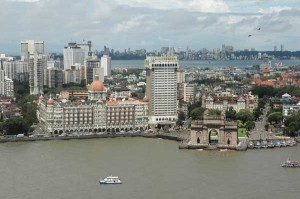The Mumbai terrorist attack of 26th November 2008 has, correctly, focused on issues concerning the security of India’s vast coastline. Earlier, in 1993, the Maharashtra coast had been used to bring in huge amounts of RDX explosives which were subsequently used by terrorists in the several blasts carried out across the metropolis. This does not mean that the coastal route has not been used for other nefarious activities before or since then.
Smuggling in and around the Gujarat coast, in particular, has been rampant for long with at least some of the people involved in preventing it, themselves in connivance. But these are two incidents of proven exploitation by terrorist groups who clearly found the sea route easier to breach than land. This is a worrisome development since the sea has traditionally been seen by Indians as a barrier, something of a stiff hurdle to be crossed by people with evil designs.
Lessons from 26/11
Before examining the full range of issues concerning coastal security, it will be useful to analyze the events of 26th November. Ten terrorists, ostensibly of the Lashkar group, embarked on a little known and not too big Pakistani vessel, the MV Al Husseini, which then headed towards the Sir Creek. Remarkably, the Research and Analysis Wing (R&AW) was able to spot this departure and reported the position of the ship; on 19th November it was south west of Karachi and in waters off the Sir Creek. Interestingly, an Indian fishing trawler from Porbander, Kuber, had obtained a permit to head towards the waters off Sir Creek on 14th September.
While support of National Security Guard (NSG) from Delhi was sought, it was not realized that an equally competent group, the Marine Commandos (MARCOS) was in immediate proximity. It could have been on the scene by midnight but came some hours later, when called.
Later events showed that this boat was either captured by the Pak terrorist group who then transferred to it or was also part of the conspiracy. In any event, the miscreants then proceeded to a position off Mumbai reaching there on the 26th November. Time and space analysis shows that the boat may well have travelled only during night hours and masqueraded as a fishing boat during the day.
Of the five crew of Kuber, four were murdered and their bodies thrown overboard. The one remaining person, probably the one who steered the vessel, was killed just before the terrorists left the boat, his beheaded body being found the next day. The group had carried a deflated rubber boat, henceforth called Gemini, which is not much more than a flat plywood bottom structure measuring 8 feet by 6 feet with rubber tube sides. The tubes were inflated and the Gemini lowered into the water. An outboard motor was put down, connected and started.
Ten men, dressed in inflated life jackets, then got into the boat, no easy task considering that the lifejacket itself hinders easy movement of the upper torso as also the fact that both the parent craft and the Gemini must have been tossing about, judging from the visuals of the next day when our Coast Guard found and boarded Kuber. Into this fragile craft were then lowered 10 AK rifles, 60 loaded magazines and 200 grenades (1 rifle, 6 magazines and 20 grenades per man) and several assembled explosives of RDX. The men sat on the rubber sides, less than two feet from the sea surface as the boat sped towards the fishing village called Machchimaar Nagar, on high profile Cuffe Parade.
Such a craft arriving there is so rare an event that it should have got the local fishermen to raise alarm but just one woman asked them who they were and was easily brushed off. The group climbed out, the busy road was just there, hailed cabs and easily moved out to their separate destinations, each man carrying at least sixty pounds of weight in assorted bags, yet arousing no suspicion. They left an RDX bomb in each of the taxis which was enough to blow them up at different places, far removed from one another.
This is how they came and got to where they did. This is not something which some civilians, howsoever indoctrinated and trained in some Lashkar camp, can do easily. Even Navy sailors, trained to do things at sea, would find the task very difficult; only Marine Commandos would, normally, be fit for such work. It is, therefore, clear that the people who came were actually commandos, either serving in the Pak Army or retired and, if not that, people trained over a considerable period of time by those who had been in the military profession. The entire operation was, undoubtedly, planned and managed by the ISI, another word for the military, with groups like the Lashkar and Jaish only being convenient fronts. It is important to comprehend this reality because this is the seriousness of the threat that India faces.
Intelligence and response are two other areas which merit examination. As mentioned earlier, the RAW reported the presence of Al Husseini on 19th November and its position. Such raw intelligence has to be analyzed in conjunction with any other information and a reasonably coherent picture developed by the agency charged with co-ordination of intelligence, in our case, the Joint Intelligence Committee (JIC). An input was received from the Intelligence Bureau (IB) on 20th September that high profile targets such as the Taj and other sea front hotels in Mumbai could be hit.
For patrols to cover the entire sea area and at all times will require resources which no country can afford and even then the sanitization might not be complete. To investigate the bona fides of even a hundred fishing boats daily requires hours of tedious work during daylight; at night it is next to impossible.
Linked together, the two bits of information should have resulted in an assessment of when the intruders could land and of the likely targets. This did not happen because there was no analysis of inputs coming in from different sources at different times which speaks poorly of the work done at the JIC. As for response, by 10 PM on 26th November, it had become clear to authorities in Mumbai that a major terrorist attack was in progress and that two of the most high profile hotels were being held hostage. Yet, while support of National Security Guard (NSG) from Delhi was sought, it was not realized that an equally competent group, the Marine Commandos (MARCOS) was in immediate proximity. It could have been on the scene by midnight but came some hours later, when called. Even then, it was tasked only to evacuate people.
This time gap allowed the terrorists to entrench themselves more firmly. As for the NSG, the contingent of 200 was ready at Delhi airport within two hours of being informed at Manesar, the base camp, but remained sitting there for another three hours awaiting the arrival of Air Force aircraft from Chandigarh. Any of the several passenger jets on the tarmac could easily have been requisitioned, saving valuable time, but this was not done. Consequently, the first response came only twelve hours after the hotels were attacked, when the NSG commandos reached the scene.
Troops summoned from the Army locally were not used in counter terrorism work but only to secure the external boundaries. There was no Operations Centre in Mumbai to coordinate activities. Failure of senior officials charged to take decisions has been passed off as a “systemic failure”. All these issues are relevant when we look at coastal security in a holistic fashion; physical resources are, no doubt, important, but they alone, will not be enough. Finally, this piece of the jigsaw must be put at its appropriate place within the overall mosaic of the country’s maritime security
The Imperatives of Coastal Security
India has a coast line of just over 7500 kilometers. On this stretch lie 13 major and nearly 200 minor ports. These, together, account for over 600 million tons of goods going out and coming in, valued at $ 500 billion in 2008-09 and doubling every five to six years. Of this, energy imports alone will total 100 million tons by 2013. So, there are thousands of ships of all sizes operating from these ports. Almost all cargoes nowadays are shipped in containers but we have no mechanism of X-raying them on arrival or requiring such certification.
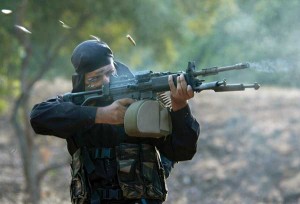 An American led Container Security Initiative, which would make it mandatory for containers to be X-rayed, has not received acceptance by India because the Left parties saw in it an insidious effort to subvert our sovereignty. Since all our cargoes reaching US ports have to have X-ray certification without which they will not be accepted, we have been left looking foolish, only leaving ourselves vulnerable. Almost anything can be carried in containers including narcotics, arms and explosives, even illegal migrants, so this is a very serious lacuna.
An American led Container Security Initiative, which would make it mandatory for containers to be X-rayed, has not received acceptance by India because the Left parties saw in it an insidious effort to subvert our sovereignty. Since all our cargoes reaching US ports have to have X-ray certification without which they will not be accepted, we have been left looking foolish, only leaving ourselves vulnerable. Almost anything can be carried in containers including narcotics, arms and explosives, even illegal migrants, so this is a very serious lacuna.
There are also hundreds of fishing villages located all round; on the Gujarat and Maharashtra coast alone there are more than 60,000 boats engaged in fishing and checking every one of them is impossible. Yet, many of them do not carry authorization permits or registration papers, making it easy for intruding boats to mingle with them and slip in. Then there are offshore platforms engaged in exploitation of oil and gas, quite vulnerable to clandestine attack. Their security is vital for the nation’s economic growth. It can not be ensured if we do not have adequate capabilities and mechanisms in place.
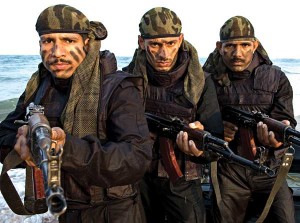 Clearly advance information of activities inimical to our interests, or Intelligence, is the first requirement. This comes from two basic sources, humans and electronics. The first is self evident — it requires penetration of the enemy’s cadres and is critical to prevention of
Clearly advance information of activities inimical to our interests, or Intelligence, is the first requirement. This comes from two basic sources, humans and electronics. The first is self evident — it requires penetration of the enemy’s cadres and is critical to prevention of
terrorist activities. The second includes all kinds of interceptions, viz. telephone chatter, emails, location of transmitters and own coastal radars. Whatever is the source, and there might be more than one coming in at different times and from several sources, the inputs will be ‘unactionable’ unless they are gelled together and analyzed and then disseminated. The task is clearly a very difficult one but that is what gathering intelligence is all about-collating, understanding, disseminating. Coastal radar stations are a link in the detection chain but in an area where there are thousands of small contacts of own fishing craft, it is not easy to even detect them, much less identify friend from foe. Further, they can not be kept on all the time and therefore redundancy, including in power supply will have to be provided apart from the manpower required for each station. So, the challenge is quite formidable and it will be facile to think otherwise.
The next line of defence is physical patrolling of the waters by ships and aircraft. This is also a psychological deterrent to potential miscreants but not difficult to breach by a determined adversary. First, for patrols to cover the entire sea area and at all times will require resources which no country can afford and even then the sanitization might not be complete. To investigate the bona fides of even a hundred fishing boats daily requires hours of tedious work during daylight; at night it is next to impossible.
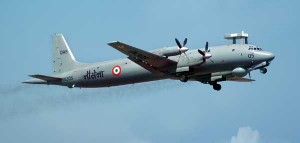 Aircraft can cover larger areas more speedily but their endurance is limited; they are also ineffective in vessel identification and check for which surface ships must be called to the scene. So, an optimum mix of patrolling platforms carrying out random searches in unpredictable ways is the only viable option. The vessels have to be small, for shallow waters near the coast, medium sized for areas farther away and still larger for operations in the open sea. The first will have least staying power on task while the last will have the most. They will, often, have to move in and out of the areas assigned to them and overlap into those of others. Good real two way communications between these craft and between them and Operations Centres on shore are absolute imperatives for meaningful work.
Aircraft can cover larger areas more speedily but their endurance is limited; they are also ineffective in vessel identification and check for which surface ships must be called to the scene. So, an optimum mix of patrolling platforms carrying out random searches in unpredictable ways is the only viable option. The vessels have to be small, for shallow waters near the coast, medium sized for areas farther away and still larger for operations in the open sea. The first will have least staying power on task while the last will have the most. They will, often, have to move in and out of the areas assigned to them and overlap into those of others. Good real two way communications between these craft and between them and Operations Centres on shore are absolute imperatives for meaningful work.
Yet another facet is to devise means to counter merchant vessels with sinister intentions which could include blowing up large quantities of explosives when docked or scuttling themselves at entrances of ports with narrow channels thereby closing all traffic, to and from, for several weeks. Many of our major ports fall in this category. One answer is not to allow any ship within about one hundred miles of our coast if it does not identify itself through an Automatic Identification System (AIS). The USA follows this practice rigidly, but we are diffident in doing so. Even this AIS requirement applies only to vessels over a certain size, 300 tons, and smaller ones could still slink in. For such crafts of Indian registry, a system of transponders is needed to separate those who we know from those we do not.
As the leading regional power, India has important responsibilities in maritime affairs of this part of the world. So far, it has restricted itself within the narrow confines of its own territorial concerns on land. This mindset must now change.
Transponders, being electronic, can also be compromised but are yet another link of the security chain. Similarly, no unlicensed movements of ships must be permitted within a certain distance of offshore platforms and there must be ‘zero tolerance’ to any violations. There must also be visible patrolling by marine police craft in ports and harbours. Everything that adds to fear of being caught is a deterrent and too much of that is not enough.
The hundreds of fishing villages spread around the coast should be treated as an asset and not a liability. They should be inducted as the Government’s ‘eyes and ears’. Small craft approaching our shores can not just come in anywhere and can also not intermingle very easily. The reason why fishing communities are located where they are is because the shallow waters are more navigable there. The same constraints will apply to intruders. Road transportation, something that intruders will need, is also more easily available from these villages than from other, uninhabited, places. Using these villages as a line of defence with police posts in every one of them is essential. Had one been there at Machchimaar Nagar on the night of 26th November, the intruders might have not been able to get as far as they did.
Finally, it is essential that all elements charged with coastal security, viz the Navy, the Coast Guard, the Marine Police, the BSF and Customs Marine Wings operate through unified Operations Centers. Such entities are essential in Mumbai, Kochi, Chennai and Visakhapatnam and in other ports where forces of more than one agency are based. Since terrorist actions do not take place every day, boredom and creeping casualness will, inevitably, compromise the best laid out defences but frequent and ‘no warning’ exercises will minimize the degradation.
The contours of the new Coastal Command, reportedly under consideration of Government, are not known but if they absorb the issues identified above, it will be a step in the right direction. Of course, all these measures will still fail if the people put in charge to lead and to give decisions shirk from doing so or if one of our own is compromised as is suspected to have happened to the Kuber. But that is no excuse for not having a system in place. In doing so, it is easy to go overboard; care must be exercised in prioritizing the needs and in putting together capabilities that will actually work. For example, the Maharashtra-Gujarat stretch is easily the most vulnerable and deserves immediate attention. Also, putting large numbers of radar stations all along the coast will not be as cost effective as putting some more boats on patrol; nothing deters a criminal as much as the presence of a policeman.
Larger Issues of Maritime Security
Issues of coastal security are not independent of the larger mosaic of maritime security. The sea is not easily partitioned into specific zones and activities in any one area can, and do, transform into others. It is, therefore, necessary to take a more holistic view of security at sea. At one level, these concerns are strategic and geopolitical. They stem from our own position as the major regional power in the Indian Ocean and the presence and activities of others. While threat of war between nation-states has diminished, it has not disappeared, and India needs to maintain maritime capabilities which are sufficiently deterrent to potential adversaries.
There is urgent need for a Maritime Commission or Agency at the apex level working to oversee all aspects connected with security issues at sea, coastal and otherwise. Such a system is functional in France and in Japan
Pakistan continues to remain an uncertain element and military preparedness must always form an important ingredient of our interface with that country. With China, the boundary dispute remains unresolved and despite significant improvement in relations between the two countries, its naval modernization and efforts to acquire an Indian Ocean profile must be factored into our own plans. So, adequate and credible deterrent capabilities at sea are important.
At another level, there are increasingly serious problems posed by non state actors; that category includes those involved in piracy as well as in terrorism at sea. People involved in the first can easily switch over to the second. About 40 percent of global seaborne commerce moves across the waters of the Indian Ocean; one fifth of this comprises oil and gas. The USA, China, France and Japan are major importers of energy from the Gulf. The east-west shipping route cutting right across the north Indian Ocean is one of the most important trade passages of the world and thousands of merchant ships move on it all the time. Yet, there are serious physical constraints in this movement. All exits and entries to and from the Indian Ocean pass through restricted waters where shipping can be interdicted even by quite poorly equipped criminals.
The Gulf of Hormuz, through which must pass all tanker traffic from that region, the Gulf of Aden heading towards the Suez Canal, the Mozambique Channel needing to be traversed enroute to the Cape and the Malacca/Sunda/Lombok Straits connecting the Indian Ocean with the South China Sea, all fall in this category. The waters off Somalia are another zone of opportunity for miscreants, otherwise known as pirates. Dozens of ships, including tankers carrying potentially dangerous chemicals, have been hijacked in this region in recent months, all for money.
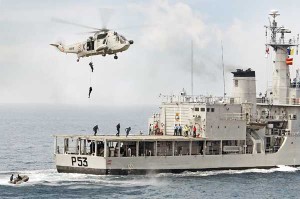 The first and positive blow against the criminals was struck by the Indian Navy when the frigate, INS Tabar, first warded off some threatening moves and later actually sank a mother vessel of the pirates. In another instance the destroyer, INS Mysore, actually apprehended some pirates. India has a serious interest in the safe movement of trade at sea as almost all of it is carried through these waters. In monetary terms, this quantum will touch $ 500 billion in 2008-09 and even with the economic downturn, should cross $ 1 trillion by 2013 and $ 2 trillion by 2020. Overseas trade, which already measures at about 42 percent of GDP, will reach 60 percent of GDP by 2015. So, its safe movement has a key role in the nation’s economic growth. This safety begins in our ports and moves across coastal waters into the open seas.
The first and positive blow against the criminals was struck by the Indian Navy when the frigate, INS Tabar, first warded off some threatening moves and later actually sank a mother vessel of the pirates. In another instance the destroyer, INS Mysore, actually apprehended some pirates. India has a serious interest in the safe movement of trade at sea as almost all of it is carried through these waters. In monetary terms, this quantum will touch $ 500 billion in 2008-09 and even with the economic downturn, should cross $ 1 trillion by 2013 and $ 2 trillion by 2020. Overseas trade, which already measures at about 42 percent of GDP, will reach 60 percent of GDP by 2015. So, its safe movement has a key role in the nation’s economic growth. This safety begins in our ports and moves across coastal waters into the open seas.
India imports about 70 percent of its energy needs, oil and gas, from the Gulf. It is expected that this quantum will increase to nearly 85 percent in the next ten to twelve to fifteen years; much of it coming into ports on the Gujarat and Maharashtra coasts. The numbers of tankers bringing this energy is slated to go up from about 4000 annually to over 7500 in 2020. At the same time, the sea area under offshore exploitation is expected to double, from 50,000 square kilometers today to 100,000 square kilometers. Maritime security is as much about ensuring the safety of these assets, ships and oil platforms, as about preventing intruders penetrating the coastal waters.
The hundreds of fishing villages spread around the coast should be treated as an asset and not a liability. They should be inducted as the Governments “˜eyes and ears.
In fact, the two are co-terminus and one supplements the other. Additionally, while India shares land boundaries with its South Asian neighbours, it also shares maritime space with Myanmar, Thailand, Indonesia and Malaysia. This proximity has its own complications in terms of poaching and illegal movement of people. Smuggling of narcotics is particularly worrisome as it results in illegal money which is then used for contraband arms and terrorism. It is well known that arms supplies for the LTTE movement in Sri Lanka have been funneled through this route across the Bay of Bengal and some vessels involved in that trade have even be apprehended and neutralized. Finally, the entire area is infested with terrorism, from the Al Qaeda group in the west to the Abu Sayyaf group operating in the Philippines in the east; in between lie the Taliban in Afghanistan, the Jaish and Lashkar groups in Pakistan, the HUJI in Bangladesh and the Jemaah Islamia in Indonesia. While these groups have largely focused on land based activities, their ability to operate at sea should not be ignored; the LTTE has given ample demonstration of what it can do over the last several years.
The attack on the American destroyer USS Cole in Aden a few years ago by Al Qaeda followed by that on the French tanker MV Limberg in the Gulf of Aden are also examples. This group has also attacked offshore platforms at Basra. The Abu Sayyaf has sunk super ferries killing hundreds of innocent people. So, the threat is real and more such acts should be expected, not less. Given its history, demographics and pluralistic society, India is especially vulnerable to targeting by such non-state actors. Finally, nearer home, as already elaborated earlier, India’s coast line is very porous. Clearly, it is necessary to take issues of maritime security far more seriously than has been done so far.
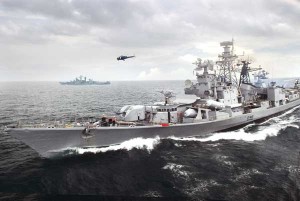 Given the restricted waters through which heavily laden cargo vessels must move into and out of the Indian Ocean, it is not surprising that piracy has been rampant in these waters. In recent years, the pirates have acquired more lethal weapons like AK 47 rifles, rocket propelled grenades and hand held satellite communication phones. Obviously, adequate capabilities are needed to cope with these threats. It must also be appreciated that the maritime sector, more than all others, is transnational. Ships owned in one country are registered in another and crewed by people from several more. They are hijacked in one area, to be taken to another, and then used for illegal activities elsewhere. So, capabilities alone will not help. Close co-operation with maritime forces of other countries is a vital necessity.
Given the restricted waters through which heavily laden cargo vessels must move into and out of the Indian Ocean, it is not surprising that piracy has been rampant in these waters. In recent years, the pirates have acquired more lethal weapons like AK 47 rifles, rocket propelled grenades and hand held satellite communication phones. Obviously, adequate capabilities are needed to cope with these threats. It must also be appreciated that the maritime sector, more than all others, is transnational. Ships owned in one country are registered in another and crewed by people from several more. They are hijacked in one area, to be taken to another, and then used for illegal activities elsewhere. So, capabilities alone will not help. Close co-operation with maritime forces of other countries is a vital necessity.
In the Indian Ocean, as the preeminent regional force at sea, India must play a proactive role to promote such engagement, both with littoral countries, many of whom do not have capabilities of their own, and with those of others who have similar interests and concerns. In recent years, Indian forces have helped Japan by apprehending a Japanese vessel hijacked in Indonesian waters and being taken to the Gulf. Ships of the Indian Navy have also provided anti-piracy cover to high value US merchant ships traversing the Malacca Straits. Something equally cooperative is necessary in the Gulf of Aden. There is need to expand upon such interfaces as ‘stand alone’ capabilities can never be enough to cope with these challenges. Joint exercises, patrols, and regular interaction are key ingredients of engagement at sea; they promote mutual confidence and trust without which meaningful cooperation and sharing of intelligence is not possible.
Finally, there are nearly two dozen agencies in the country which are connected with sea based activities in one way or another. Apart from the two principal maritime forces, the Navy and the Coast Guard, the BSF has a Marine component. Coastal states have their own Marine Police units, even if very inadequate, and the Custom has a preventive Marine Wing. All major ports have different kinds of vessels, the Offshore and Natural Gas Commission (ONGC) has its own ships involved in providing support to offshore platforms, the Department of Oceanography has ships carrying out research. There are also others, e.g. the Departments of Lighthouses and Fisheries.
Lack of Operations Centre in Mumbai to coordinate activities and failure of senior officials charged to take decisions have been passed off as “systemic failure” but now it needs to be improved urgently for the countrys maritime security.
There is no centrally available information on the resources of all these agencies, those that are functional and those that are not or where they are deployed, resulting in both confusion and under utilization of assets. For example, during the Tsunami disaster in 2004, our assistance would have been far more productive if assets available with these agencies, not just of the Navy and the Coast Guard, had been utilized. Similarly, ships of the Navy and the Coast Guard have frequently challenged unidentified vessels at sea only to find that they belonged to one of our own departments. There is urgent need for a Maritime Commission or Agency at the apex level working to oversee all aspects connected with security issues at sea, coastal and otherwise. Such a system is functional in France and in Japan and we would do well to learn from them. Under this arrangement there would be an Operations Center at New Delhi connected with subordinate centers mentioned earlier, all networked in real time and functioning round-the-clock. Modern technology permits quick collation, analysis and dissemination of information.
A proposal to institute such a system has been languishing in the corridors of Government for some time, but bureaucratic cussedness and an obsession to safeguard turfs has prevented any progress. There are reports that the Government is now considering creation of a Maritime Security Adviser in the PMO to co-ordinate the activities of these several agencies. Better late than never, even if at a terrible cost.
Conclusion
Ever since it became a free and independent nation, India’s security concerns have remained focused on preserving its land borders. Such challenges have diminished in recent years but they have not disappeared. There is, therefore, need for vigilance. Economic growth is now becoming an increasingly important in the context of national power. While some of its prerequisites, such as internal stability and societal harmony are internal, others, viz. energy security and overseas trade depend upon tranquility at sea; as the economy grows so will their importance. To these concerns must now be added, the dimension of coastal security, an area not taken seriously thus far.
In short, the focus of India’s security interests is now shifting towards the sea. These include not just traditional areas of concern but newly emerging ones from non-state actors. As the country adjusts to its changing security perceptions, the sea is acquiring dimensions that it did not have earlier. As the leading regional power, India has important responsibilities in maritime affairs of this part of the world. So far, it has restricted itself within the narrow confines of its own territorial concerns on land. This mindset must now change. If the tragic events of 26/11 act as a catalyst in doing this, the price would have been well paid.




